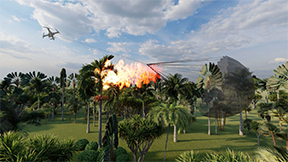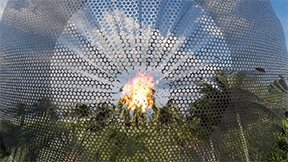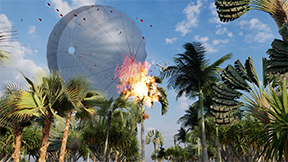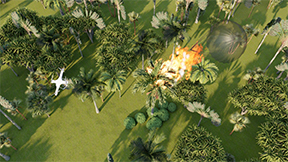FRED: Revolutionizing Firefighting
with Cutting-Edge Ember Drone Technology
Meet FRED, the First Responder Ember Drone,
and its Game-Changing Approach to Tackling Wildfires
Introduction:
In the vast and unpredictable world of wildfires, one innovative technology is making its mark. Enter FRED, the First Responder Ember Drone, a groundbreaking netting system powered by unmanned aerial vehicles (UAVs) that promises to revolutionize firefighting efforts. With its ability to capture and suppress flying embers, FRED aims to be at the forefront of preventing the rapid spread of fires, safeguarding lives, and protecting our environment.
Unleashing the Power of Netting and UAVs:
FRED's netting system is unlike anything we've seen before. It combines layers of fire-resistant material, including Kevlar®, to create a robust and durable mesh capable of withstanding the harshest fire conditions. The result? An effective barrier that intercepts and neutralizes flying embers before they ignite new blazes, halting the relentless advance of wildfires.
But what truly sets FRED apart is its utilization of UAV technology. These battery-powered drones, equipped with state-of-the-art artificial intelligence, take flight to keep the netting system afloat and accurately position it to intercept embers with precision. This cutting-edge approach eliminates the need for human intervention in high-risk fire zones and enhances the effectiveness of firefighting operations.
From Wildfires to Pollutants: A Versatile Solution:
While FRED's primary focus is on combatting wildfires, its potential applications go far beyond. The netting system's versatility allows it to be adapted to various scenarios, including the containment of pollens, airborne dust, pollutants released during construction or demolition, radioactive material, debris from natural disasters, and even airborne pests like locust swarms. This flexibility positions FRED as a multifaceted solution to diverse environmental challenges.
Coordination and Adaptability: The Power of Swarm Drones:
In scenarios requiring extensive coverage, FRED's swarm drone capability comes into play. By coordinating multiple UAVs, the netting system can be deployed across larger areas, efficiently intercepting flying embers and ensuring maximum containment. These drones communicate autonomously, constantly adapting the shape and size of the netting system to capture embers effectively, all without human intervention. It's a marvel of technology that harnesses the power of AI to protect our surroundings.
Stationary Operations and Beyond:
FRED's capabilities extend to stationary operations as well. By coupling the UAVs with lifting kites or balloons, the netting system can be deployed at fixed locations, such as along highways or freeways vulnerable to wind-driven wildfires. This setup allows for continuous surveillance and ember interception, with the UAVs remaining powered by external batteries or supplied with water or fire-retardant material through ground connections. The possibilities are limitless.
The Investment Opportunity:
Recognizing the immense potential of FRED's technology, venture capitalists have set their sights on this innovative solution. A proposed investment of $100 million aims to fuel FRED's growth, providing the necessary capital for research and development, scaling production, marketing, and expanding the sales team. With projected revenues reaching impressive figures within the first few years post-investment, an IPO exit strategy appears to be the most favorable option, offering investors a chance to capitalize on FRED's valuation growth and achieve substantial returns.
Looking Ahead:
FRED's pioneering approach to wildfire management holds the promise of reshaping how we combat environmental threats. By combining netting systems and UAV technology, FRED showcases the immense potential of innovation in preserving lives, protecting our ecosystems, and minimizing the devastating impacts of wildfires. With ongoing advancements, we may witness a new era where human ingenuity and cutting-edge technology work hand
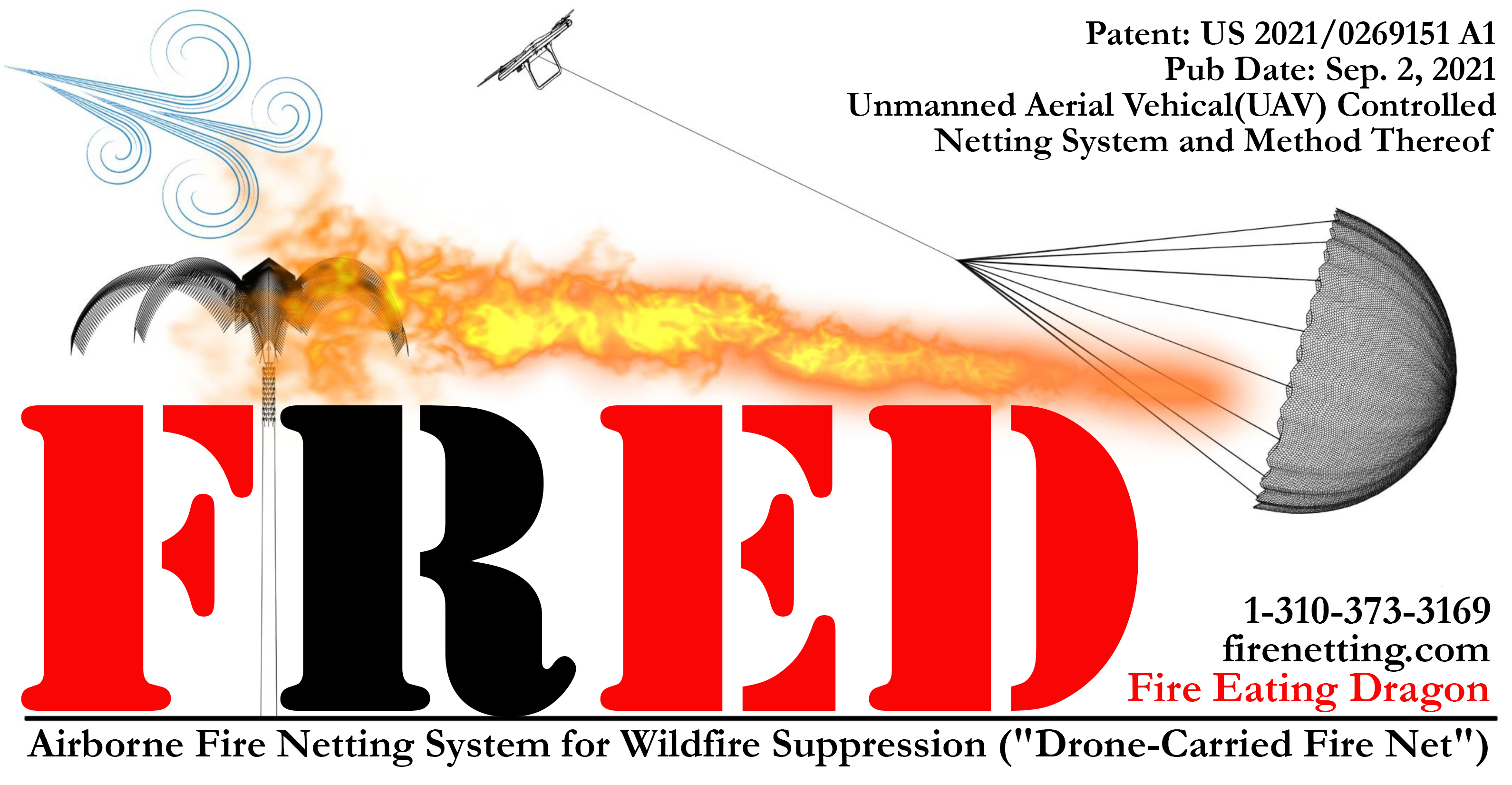
The Prospect
FRED, the First Responder Ember Drone, combines three primary R&D components:
Drone technology, with a focus on heavy lifting capabilities and stability in 70 mph wildfire wind conditions.
Wind-tunnel and in-situ testing of fire retardant paranetting material and weave dimensions.
Artificial Intelligence (AI) for the identification of "Tree Bombs" that are likely to generate ember storms during wildfires. The AI is tasked with interpreting thermal data, real-time wind data for anticipatory measures, and real-time flight control. The aim is to orchestrate a swarm of drones, allowing a single operator to control multiple FRED units.
While the technical feasibility of this project is established (please refer to https://firenetting.com/brad for a video demonstration), each R&D component requires a team of experts familiar with their respective domains and resource management to reach our goals. Our FRED product will be designed to operate with any drone that can fulfill its lift requirements and needs for high-wind stability. Even though we will be developing custom drone models for our R&D, we envisage deployment potential beyond our initial drone efforts. Our target is a 20-minute flight time in high-wind wildfire conditions, with plans for continual substitution and rotation of FRED units.
The choice of paranetting design and materials is crucial to our success. The high temperatures generated by a stream of wildfire embers necessitate materials capable of withstanding these conditions. Kevlar thread is a logical starting point, but various other material options and configurations are available.
This R&D endeavor will pave the way for practical engineering solutions to deploy and enhance this product. The challenge of merging the envisioned FRED technologies within the Epiphany Bubble is not to be underestimated – this is not simply a case of scaling up an existing design.
The fundamental questions - Can a net capture embers? Can a net fly? - have been answered affirmatively. This lays the groundwork for the next phase of development, including refining AI capabilities, thermal imagery, drone power for high winds, material science to withstand intense heat from high-wind ember streams, remote piloting, and processing a multitude of sensor data streams such as NASA fire satellite data, real-time wind maps, and in-situ FRED sensor data.
FRED has been invited by the University of Oregon at Corvallis to conduct tests during their tree burning experiments for wildfire ember research, conducted in May and October. These real-world testing opportunities will further our understanding of ember storms compressed into "heated plasma streams" by high winds. Your funding will be put to work immediately.
FRED carries the potential to drastically reduce the devastation caused by wildfires worldwide. Every year, wildfires inflict enormous damage, leading to loss of lives, destruction of homes and infrastructure, and economic loss amounting to billions of dollars. As climate change increases average temperatures, the toll taken by wildfires is predicted to rise. FRED offers an innovative approach to wildfire suppression by intercepting airborne embers before they can spread the fire further.
Our system, carried aloft by drones, is designed to halt the embers as they are launched, significantly slowing the spread of wildfires and providing additional time for firefighting efforts and evacuations. Leveraging the power of battery-operated high-lift-capacity drones, this invention can rapidly deploy fire netting over rugged, inaccessible terrain in wildfire zones.
The drones, typically equipped with video cameras for remote operation and auto-return features, will also incorporate thermal sensing and imaging, as well as AI-powered pattern recognition to autonomously identify and target ember sources. In addition, drones can be programmed to operate as a swarm, thus increasing the area of effect.
The fire netting, preferably made from a strong, lightweight, fire-resistant material like Kevlar®, is designed to capture flying embers while allowing wind to flow through. Variations of this system may include parachute-shaped netting tethered to a single UAV, rectangular netting carried by two or more drones, netting held aloft by kites, and even tethered drones supplied with power and fire suppressant material from the ground. These configurations allow for both mobile and stationary operations, depending on the situation.
In essence, FRED is more than just a tool; it's a potential game-changer in the fight against wildfires.
Read the Patent
Presented herein are systems and methods for managing a netting system via an Unmanned Aerial Vehicle (UAV). The netting system comprises a plurality of layers arranged in a mesh-like form, each displaying fire-resistant properties. Further, a battery-powered UAV is situated at an aerial location. This UAV is connected to the mesh netting and retains the netting in a floating state, adjusting its position to cover specific sources of flying embers.
Additionally, a lifting kite, connected to the UAV at one end and the mesh netting at the other, is provided. This kite lifts and holds the netting aloft when the UAV carries the kite to a higher position such that a particular ember source is covered by the mesh netting.
UNMANNED AERIAL VEHICLE (UAV) CONTROLLED NETTING SYSTEM AND METHOD THEREOF
CROSS-REFERENCE TO RELATED APPLICATIONS
This application claims the benefits of priority under 35 U.S.C. § 119(e) to U.S. Provisional Application No. 62/982,450, filed on Feb. 27, 2020, which is hereby incorporated by reference in its entirety.
FIELD OF THE INVENTION
This invention pertains to the field of wildfire control and suppression. More specifically, it relates to a system and method utilizing a mesh netting managed by an Unmanned Aerial Vehicle (UAV) for the containment and suppression of wildfires.
BACKGROUND OF THE INVENTION
Wildfires can consume millions of acres of land and forests with astonishing speed, inflicting significant damage to life, property, and the environment. These fires often last for days, weeks, or even months. Unlike other natural calamities such as earthquakes and landslides, wildfires can be largely controlled and their damage can be mitigated. Thus, there are substantial opportunities to deploy firefighting resources swiftly and effectively to protect life, property, and the environment, as well as to extinguish or limit the wildfire's intensity and spread.
Conventional wildfire fighting mechanisms that apply water or fire-suppressing chemicals from the ground may face challenges including lack of adequately trained personnel, threats to firefighter's lives, unpredictability of wildfires, scarcity of water or chemicals, and difficult terrains. Therefore, there is a need for a more efficient and cost-effective technique to combat the spread of wildfires.
To address these challenges, the present invention discloses a netting system and method held aloft and controlled by an Unmanned Aerial Vehicle (UAV). This airborne mesh netting captures flying embers from trees that act as "fire-bombs", preventing them from travelling far or hitting fresh fuel-rich ground before they land. By capturing and containing these embers, the invention may slow down the spread of the wildfire, aiding other firefighting efforts and providing valuable time for evacuation or safety preparations.
In one aspect, the invention includes UAVs that are battery-powered drones. These drones have the capacity to carry heavy loads, unaffected by smoke and fire, which could choke a UAV or manned aircraft powered by an internal combustion engine. They are equipped with video cameras for remote operation and automatic "return to base" capability if communication with the base station controller is interrupted. These UAVs can be equipped with thermal sensing and imaging capabilities and have the ability to autonomously identify and target ember sources through Artificial Intelligence (AI) and image or pattern recognition algorithms.
The drones are programmed to operate either as a group or independently to avoid each other while carrying out similar tasks. The netting, made from strong, lightweight, and fire-resistant material like Kevlar® or similar, is carried and held aloft by two or more drones for capturing flying embers.
In one aspect, the netting is shaped like a round parachute and is tethered to a single UAV by a fire-resistant cord. Alternatively, the netting can be square or rectangular in shape and be carried by multiple UAVs positioned at each corner of the netting.
The invention also uses lifting kites to hold the netting aloft during stationary operation. The weight of the netting is borne by the kites rather than the UAV, thereby extending the UAV's flight time. UAVs may carry a small supply of water or fire-suppressant material to be sprayed on the embers that have been caught in the netting.
During stationary operation, the UAVs can be tethered to the ground and supplied with electrical power from a direct source. They may also be supplied with water or fire-suppressant material from the ground via a tube or hose. Alternatively, UAVs may carry an onboard supply of fire-suppressant material to be sprayed onto embers caught within the net.
[0015] The drone can carry a special net and place it over a tree, like a palm tree. It can do this before or after the tree is on fire. The net surrounds the tree, which can help to greatly reduce the amount of big, burning pieces that fall from the tree.
[0016] The special net can be combined with a lifting kite during the kite's construction. This forms a big, self-lifting fire net. The self-lifting fire net can be precisely moved and placed by one or more drones that preferably use electric power.
[0017] This invention also introduces a way to use a drone to control a net used to stop wildfires from spreading. This involves using a lifting kite and/or one or more drones to lift a net made from a material that resists fire. Then, it can carry this fire net and place it near a source of embers. This can allow it to catch embers that fall from the source before they are blown away by the wind and start new fires.
[0018] This invention can also be used in stationary environments, where drones and/or lifting kites stay in one place. Examples of such environments include properties protected by an airborne fire net system around their edges, single buildings, tall trees, or other things that are especially at risk from fire. It can also be used where a fire line is needed, like along a freeway that already serves as a natural fire barrier. This can prevent wildfires from spreading across the freeway due to flying embers.
[0019] The system and method described can catch flying embers to stop wildfires from spreading. Moreover, they can be used in other situations as well, such as containing pollen from plants, airborne dust and debris from construction or demolition sites, radioactive material from volcanic eruptions, debris from earthquakes or landslides, locust swarms or similar pest infestations, and so on.
[0020] A key advantage of this invention is the net itself. It's designed as a strong, lightweight mesh that resists fire.
[0021] Another advantage is that the lightweight net can be carried and held by the drone even in strong winds.
[0022] The net also has a multi-layered structure that maximizes its ability to catch fire embers, while still letting wind pass through with minimal resistance.
[0023] Additionally, the lifting kite can bear the weight of the net, which can significantly increase the drone's operating time.
[0024] The invention is summarized above and is not intended to limit the important and essential features. Its purpose is not to restrict the protection of the claimed invention.
Next, there are several figures (pictures or diagrams) that illustrate the invention:
[0026] FIG. 1 shows an example of a drone-controlled net system that looks like a parachute. It's designed to catch embers during a wildfire.
[0027] FIG. 2A shows an example of how to attach the net to a drone.
[0028] FIG. 2B shows a top view of the net.
[0029] FIG. 3A shows an example of a net supported by multiple drones during an operation where everything is airborne.
[0030] FIG. 3B shows an example of a net system used in a stationary operation. This uses a lifting kite and weights to keep the net in place.
[0031] FIG. 4 shows an example of a net system with multiple drones during a stationary operation. This uses weights to keep the net in place.
[0032] FIG. 5 shows an example of a net system supported by an external battery and water supply.
[0033] FIG. 6 shows an example of a net system supported by a fire truck or similar vehicle.
[0034] Now, we will describe this invention by looking at some more detailed examples. But remember, the invention could take many forms and isn't limited to these examples. The idea is to give a complete and thorough understanding of the invention.
[0035] Unless we define them differently, all the technical and scientific terms used here mean the same as what any person with a standard knowledge in this field would understand. We're using these terms only to describe specific examples and not to limit what the invention could be.
[0036] Let's start with FIG. 1, which shows an example of a drone-controlled net system designed like a parachute. This system is used to catch flying embers that come from a wildfire. These embers can get carried away by strong winds from burning trees and help the fire spread to surrounding areas.
[0037] The system includes a drone and a net that is attached to the drone. The drone could also be a manned or semi-autonomous aircraft. The drone can have various sensors not shown in FIG. 1. These sensors could measure temperature, wind speed, GPS location, pressure, and even detect things like radiation, dust, embers, movement of gases or liquids, and presence of fire. The net is tied to the drone at a certain attachment point which could either be built into the drone or added later.
[0038] When the drone lifts the net into the air, the net takes a round, bowl-like shape similar to a parachute. The net is made of a fire-resistant material with a weave that can change based on current wind conditions. The drone can control the weave's size or how many holes it has based on changing wind conditions, the size of the embers, or the intensity of the fire. This information could also come from a satellite or a base controller that can talk to the drone. The fire-resistant material can have multiple layers to better catch flying embers.
[0039] Once the embers are caught in the net, the drone can also spray water or a fire-resistant chemical on them. The drone could carry a container with water or the fire-resistant chemical. Or, a different drone could do the spraying.
This document describes a special drone (also called UAV 106) that can fly on its own or be controlled from a distance. This drone can be different types, such as ones with propellers like a helicopter, or even a satellite. It might have three, four, six, or eight propellers. The drone can fly to a certain height above the ground and perform several preset tasks.
One of these tasks could be scanning an area with a wildfire using sensors, cameras, and thermal imaging to understand the overall area affected by the fire. Another task might be to measure specific details about the wildfire, like the direction and speed of the wind, the intensity of the fire, or the size and quantity of embers being thrown off by the fire.
The system being described could include many drones like the one above, and each one could carry a net to catch the flying embers. The net would be stored inside the drone and automatically deployed when the drone gets close to the fire. The drone uses temperature and proximity sensors to know when it's close enough to the fire.
Aside from the sensors, the drone also has a processor, memory, and a communication module which are all connected. The memory holds instructions for the drone on how to control the net to catch the embers and stop the fire from spreading. The drone uses the communication module to talk with a controller, a satellite, or other drones nearby.
The drone's memory also includes artificial intelligence (AI), an image processing module, and a coordination module for working with other drones. The AI has been trained with historic data from different wildfires around the world, so it can make good decisions about how to handle various wildfire situations. The data includes things like the location, size, speed, and direction of wildfires; the time of year; the weather; the type of trees; the size of embers; and more.
The AI can also learn from humans. If a person at a control station takes over the drone to position the net better, the AI can learn from that experience for next time. It can also learn from other drones in the system. This information can be updated in the AI on a regular basis.
In addition to learning from humans and other drones, the AI can adapt its actions on its own when it comes across a new situation. This means it can help the drone react to unexpected events that a human might not be able to handle.
When the drone is operating during a wildfire, it collects data from the area around the fire using its sensors. This data helps the AI decide what actions the drone should take. The drone might take photos of the area or create a 3D map, for example. This information helps the people controlling the drone develop a strategy for fighting the fire.
The drone can also track how many embers it catches with the net, and it shares this information with the control center.
The drone is powered by a battery that can work in smoky and windy conditions. It might even use solar power for nearly continuous operation. If only one drone is used, the net might be supported by a rig from the drone and a weight at the bottom of the net to help spread it out and keep it in position.
The patent continues detailing the application and use of the netting system designed to control the spread of wildfires, as well as other applications such as pollen, dust, and debris containment.
Paragraphs [0051] and [0052] describe how the fire-resistant netting can be attached to UAVs. The netting is attached to the drone using a fire-resistant cord through a top hub. The netting can also be made of layers of flame-retardant fabric, like Kevlar®. The netting could have a set of flame-retardant fabrics arranged as mats of the same size and shape for easy transportation. It also mentions that the mesh of the netting can be created with openings smaller than one inch.
In paragraphs [0053] to [0055], the patent explains the flame-retardant fabric may contain at least one woven layer of silica glass, possibly combined with aramide and/or aluminum silicate. The fabric can be constructed of multiple layers and is fire-proof, providing a physical barrier against flying sparks, embers, or flames. The netting can be made into various shapes and structures, including shutters, curtains, sheets, and mats. The patent also mentions the netting might be rolled up and attached to the UAV for deployment.
Paragraphs [0056] to [0059] go into the specifics of how multiple UAVs might be used in tandem to support a large netting system. A group of drones can form a swarm drone system, where they communicate and coordinate to maintain the net's position and adapt its size and shape to maximize the capture of flying embers. AI modules in each drone could enable this coordination without manual intervention. Some drones can also carry water or fire-retardant fluid to spray on the netting when embers are caught, and others could provide a ballast to lessen the weight load.
The drones could be remotely controlled with autonomous features, and the UAVs could be designed to carry the netting as a roll for easier transportation and quicker response to the affected area.
This excerpt seems to be a continuation of a patent document, detailing different ways to deploy a netting system to capture flying embers from wildfires. Various embodiments and potential configurations of the system are described.
In Paragraph [0060], a stationary operation scenario is described where a lifting kite is used in conjunction with a UAV to keep the netting aloft. The kite lifts the netting while the UAV maneuvers it into place. The netting is anchored to the ground with ballasts, preventing it from being carried away by high-speed winds. The lifting kite is designed to work in various conditions and can lift payloads such as antennas. This arrangement allows for longer UAV flight times as the kite handles the task of keeping the netting afloat.
Paragraph [0061] describes how the UAV, powered from a ground station, can also be supplied with a water or fire-retardant chemical supply to dampen the netting and extinguish captured embers. This stationary operation scenario can be used along highways or other suitable locations to control wildfires.
In Paragraph [0062], a multi-UAV setup is explained. Multiple UAVs maneuver different lifting kites, changing the direction of the netting's deployment. These UAVs can also be tethered to the ground and be supplied with fire-retardant material from the ground through a connecting tube.
In the configuration mentioned in Paragraph [0063], the netting is held aloft by lifting kites and the UAVs position it at the desired location to catch the embers. The UAVs can also release the netting over a source of embers to prevent their further release.
Paragraphs [0064] and [0065] describe setups where the UAVs are powered by external batteries or a water supply, extending the duration the netting can be kept afloat. In these embodiments, the netting is tethered to the UAVs and kept in position by anchors.
In Paragraph [0066], the netting system is attached to a fire truck or other vehicle, replacing the need for ballasts or external batteries. The fire truck can provide power and a continuous water or fire-retardant supply to the UAVs, extending their operational time.
The last paragraph [0067] introduces the possibility of using additional vehicles to pull the netting taut and allows for a larger netting size, depending on the distance between the two vehicles. The document concludes by stating that these descriptions of embodiments are not exhaustive and can be modified or varied.
hese statements are the claims of a patent document describing an unmanned aerial vehicle (UAV) controlled netting system. They lay out the specifics of the invention being claimed and describe its unique features.
Claim 1 describes a netting system involving a mesh netting, composed of interspersed layers of fire-resistant nettings, and a battery-powered UAV. The UAV is used to maintain the mesh netting afloat at an aerial location and can adjust its position to ensure that a specific source is covered with the mesh netting.
Claim 2 describes a similar netting system, but here the UAV is directly powered and is present at a ground location. In this system, a lifting kite is used, which is coupled to the UAV at one end and attached to the mesh netting at another end. The lifting kite is responsible for carrying and holding the mesh netting aloft when the UAV brings the lifting kite to an elevated position. Again, this system ensures a particular source is covered with the mesh netting.
Claim 3 outlines a method for controlling a netting system using at least one UAV. The UAV carries aloft a mesh netting made of fire-resistant material. The UAV is then positioned to catch material released from a specific source within the mesh netting.
| 
